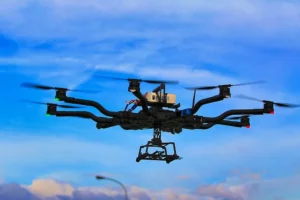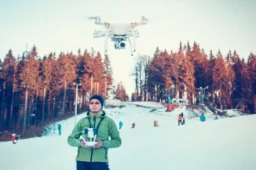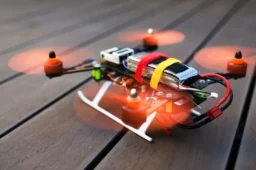
How Fast Can a Drone Fly
How fast can a drone fly? It is common questions, although it is depend many of the specific matter. Here writing some effective point, that you can help it. Drones, those ubiquitous buzzing bots in the sky, come in all shapes and sizes, packing vastly different speeds based on their design and purpose. So, the answer to “how fast can a drone fly” isn’t a simple one. Buckle up, as we take a whirlwind tour of the drone speed spectrum:
The Chill Cruiser:
Your average consumer drone, built for leisurely aerial photography or casual exploration, typically cruises at a comfortable 25-50 kilometers per hour (15-30 mph). Think scenic shots or light mapping, not chasing Usain Bolt.
The Speed Demon:
Craving adrenaline (and a potentially shorter lifespan for your drone)? Racing drones are built for agility and raw speed, often exceeding 160 kilometers per hour (100 mph). Imagine navigating tight courses at breakneck speeds, feeling the virtual G-forces through your goggles. The current world record, a mind-blowing 360 kilometers per hour (224 mph), belongs to this category.

The Workhorse:
Industrial and professional drones prioritize stability and payload capacity over speed. They typically hover around 50-80 kilometers per hour (30-50 mph), efficiently carrying survey equipment, delivering packages, or inspecting infrastructure. Think precision over Sonic the Hedgehog.
The Stealthy Intruder:
Military drones prioritize covertness and long-range capabilities. Speeds vary depending on the mission, but they usually range from 130-300 kilometers per hour (80-185 mph). Think high-altitude reconnaissance or targeted operations, demanding both speed and discretion.
Beyond the Horizon:
Remember, these are just broad categories. Custom-built drones push the boundaries constantly. Fixed-wing hybrid VTOL drones, for example, can transition from helicopter-like takeoff to efficient fixed-wing cruising, reaching speeds exceeding 350 kilometers per hour (217 mph). The future of drone speed promises to be even more exciting, with concepts like jet-powered drones and hypersonic designs on the drawing board.
How fast can military drones fly
Military drones come in all shapes and sizes, with vastly different capabilities and purposes. It depends on the specific drone and its mission. Here’s a breakdown of different categories and their typical speed ranges:
Slow and Steady Surveillance Drones:
- Speed: 30-100 mph (48-160 km/h)
- Examples: RQ-11 Raven, ScanEagle
- Purpose: These drones prioritize endurance and loitering time over speed, providing persistent surveillance at lower altitudes.
Fast and Furious Attack Drones:
- Speed: 200-400 mph (320-640 km/h)
- Examples: MQ-9 Reaper, Predator B
- Purpose: These drones prioritize firepower and target engagement, needing enough speed to close in and deliver their payload effectively.
Hypersonic Screechers:
- Speed: Mach 5+ (3,800+ mph or 6,100+ km/h)
- Examples: SR-72 (under development), Boeing X-51 Waverider
- Purpose: These drones push the boundaries of speed for high-altitude, long-range reconnaissance and potential strike capabilities.
Beyond Speed: Other Factors to Consider:
- Altitude: Higher-flying drones often prioritize efficiency over speed.
- Payload: Carrying weapons or sensors adds weight, impacting speed.
- Mission requirements: Speed might be less important than stealth or maneuverability for some missions.
Here are some specific examples to illustrate the range:
- The tiny, hand-launched RQ-11 Raven: cruises at a leisurely 20 mph (32 km/h) but can reach bursts of 40 mph (64 km/h) for short sprints.
- The jet-powered MQ-9 Reaper: packs a punch with a top speed of 400 mph (640 km/h).
- The experimental SR-72: aims to match its manned predecessor’s hypersonic speeds exceeding Mach 6 (4,600 mph or 7,400 km/h).
So, the next time you hear about a military drone, remember that “fast” is a relative term. Their speed depends on their design, mission, and the ever-evolving landscape of drone technology.
DJI Drone Speed
Factors Affecting DJI Drone Speed:
- Model and Class: DJI caters to various needs, from beginner-friendly Minis to professional cinewhoops like the FPV. Each model boasts distinct motor power, weight, and aerodynamic design, significantly impacting speed.
- Flight Modes: Most DJI drones offer multiple flight modes (e.g., Normal, Sport, Manual) prioritizing stability, agility, or raw speed. Understanding these modes and their limitations is crucial.
- Environmental Conditions: Wind resistance, altitude, and temperature can dramatically affect performance. Flying at high altitudes or battling strong winds reduces available speed.
Unlocking Speed Potential:
- Master Flight Modes: Experiment with different modes, gradually pushing boundaries while understanding safety limitations. Remember, exceeding manufacturer-recommended speeds can be dangerous.
- Consider Advanced Models: Drones like the FPV (87 mph) or Mavic 3 (75 mph) prioritize speed, but responsible piloting and adherence to regulations remain paramount.
- Embrace Third-Party Props: Aftermarket propellers can offer slight speed improvements, but prioritize reputable brands and ensure compatibility to avoid compromising stability or safety.
But Wait, There’s More!
- Regulations: Drone speed limits vary by region and airspace. Always fly within legal boundaries.
- Battery life: High speeds drain batteries faster. Factor in flight time for your planned use.
- Controllability: Piloting a fast drone requires skill and practice. Don’t push your limits or endanger others.
So, how fast can a drone fly? It depends on its purpose, design, and your piloting skills. Choose wisely, fly safely, and enjoy the amazing aerial possibilities! Hope you get right answer for your questions. Thanks, Have any others questions about drone, please inform me.





